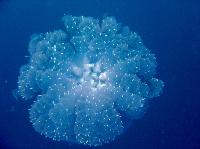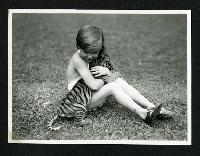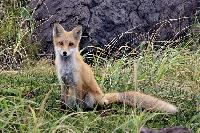Amazing Animals
71. The Face of a Killer
The visage of a tiny velvet ant peers up in this scanning electron microscope image magnified 23 times. This tiny creature, genus Dasymutilla is not actually an ant at all, but a wasp. She (this is a female) boasts a nasty sting, especially if you re another wasp or bee. In order to reproduce, velvet ants lay their eggs inside the larvae of wasps and bees. When the eggs hatch, they feed on the still living but paralyzed larvae that house them.
72. Points of Light
Here s a marine mystery for you: What is this glowing creature emerging from the depths? If you recognized it as the underside of a jellyfish, congrats! This photograph was captured near the wreckage of the Shinkoku Maru, a World War II era Japanese oil tanker sunk by a torpedo attack in 1944. The shipwreck now rests in the Chuuk Lagoon in Micronesia.
73. Daring Rescue
Divers free a Hawaiian Monk Seal entangled in a lost fishing net in this 1997 photograph from the Northwestern Hawaiian Islands. Fortunately for this unlucky seal, the divers were successful. Marine litter remains a problem in the area more than a decade later, however. In July 2012, NOAA divers plucked 50 metric tons of marine debris out of the Pacific near the islands during a single clean up mission.
74. Cub Cuddles
Don t try this at home: An unidentified child cuddles a tiger cub during the 1937 National Geographic Society Smithsonian Expedition to the Dutch East Indies, now Indonesia. The purpose of the expedition was to collect zoo animals for the National Zoological Park.
75. Hello Friend
A male northern elephant seal watches a shorebird trot by in this photograph from the Monterey Bay National Marine Sanctuary in California. Male elephantseals earn their name with their enormous size, growing up to 13 feet (4 meters) long and weighing up to 4,500 pounds (2,000 kilograms).
76. Emperors Gravity Defying Leap
I can fly! I can fly Well, maybe not. Emperor penguins may be flightless, but as this 2011 shot reveals, they re perfectly adapted to their semi aquaticlifestyle. These penguins can dive more than 1600 feet (500 meters) down for up to 12 minutes. After a completed hunting spree, the birds launch themselves back onto the ice like feathery torpedoes.
77. Happy Halloween
If you prefer your creatures of the night to be cute rather than cuddly, have we got the critter for you. This is an aye aye, a species of nocturnal lemuroriginally found only in Madagascar. The aye aye is a harmless omnivore with one long, spindly finger it uses to fish grubs out of rotten logs. Like 91 percent of lemur species, aye ayes are threatened with extinction, but it s not just habitat loss and deforestation that may do this fuzzy creature in. Madagascar superstition holds that aye ayes are harbingers of death, so the animals are often killed on sight.
This particular aye aye is a resident of the Duke Lemur Center in Durham, N.C., a research and conservation facility that houses 250 lemurs and their close relatives. In honor of Halloween and the wrongly maligned aye aye, the Lemur Center has a special deal for the month of October: Pledge a donation and receive not only a packet of information about a lemur of your choice, but also this cute photo.
This particular aye aye is a resident of the Duke Lemur Center in Durham, N.C., a research and conservation facility that houses 250 lemurs and their close relatives. In honor of Halloween and the wrongly maligned aye aye, the Lemur Center has a special deal for the month of October: Pledge a donation and receive not only a packet of information about a lemur of your choice, but also this cute photo.
78. Guardian of the Lava
What are you doing at my rock outcrop? Geology fieldwork sometimes brings scientists face to face with local fauna, like this curious red fox living in a lava field on Iturup Island. This volcanic island is part of the disrupted territory between Russia and Japan, with both nations claiming it as their own
79. Alien Anemone
Looking nearly unreal with its green and purple color scheme, this anemone decorates the ocean floor near Chuuk, one of the Federated States of Micronesia. Despite the vegetal look, anemones are actually animals that prey on small fish and crustaceans.
80. Cuddly Cuties
Two cuties get cuddly in this 1937 photograph taken on a National Geogrpahic Society Smithsonian Institution expedition to the Dutch East Indies (now Indonesia). This image is part of the collection of William Mann, director of the National Zoo, and Lucile, his wife and a writer and editor, but the Smithsonian knows little about this strangely cozy primate and tiger cub.














